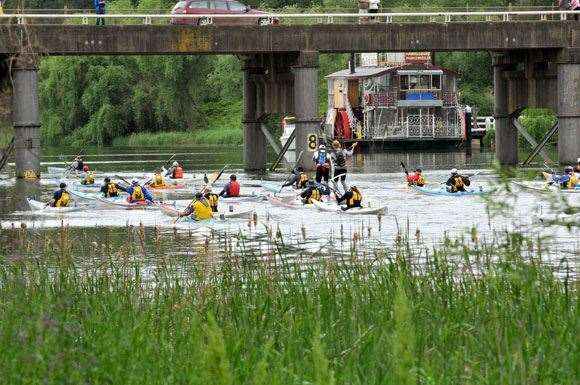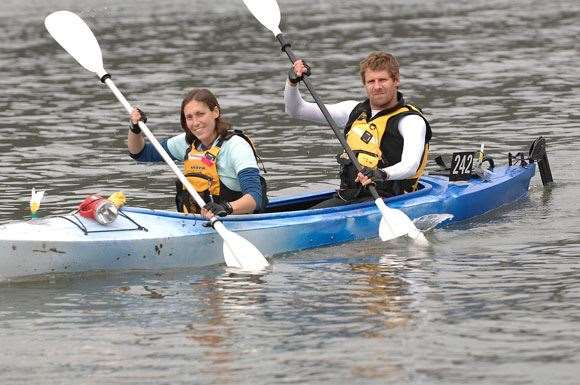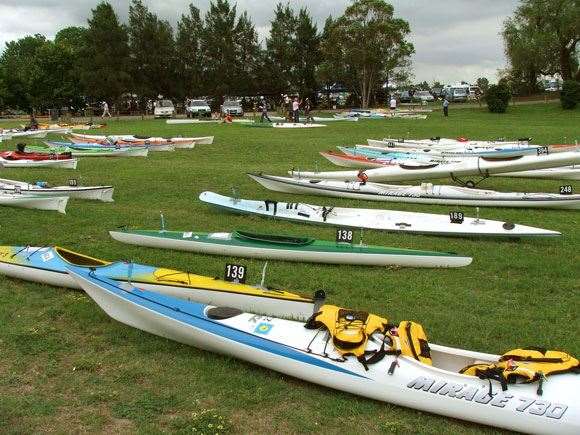The monotony of the 111km Hawkesbury Classic plays havoc with your arms, back, hamstrings … and especially your mind.
The monotony of the 111km Hawkesbury Classic plays havoc with your arms, back, hamstrings … and especially your mind.
 At least the scenery's pretty, Images: The Hawkesbury Classic
At least the scenery's pretty, Images: The Hawkesbury ClassicIt’s the defining point of my race and it arrives 20 minutes before the starter’s gun. Crowds of paddlers are massed on a grass bank overlooking the start line. The mood is jovial – the smoke of a sausage sizzle, last-ditch coffees, final photos. I’m standing beside my kayak, rolling my paddle from hand to hand, quietly absorbing the festive air, when an old bloke with knotted knees shuffles past. He stops and looks sorrowfully at my kayak: “Gee, you’re brave, mate.” His words fire panic in my stomach. I look at the other kayaks ranked on the grass. It dawns that none of them look like mine. They look like rapiers: long, thin, fibreglass splinters that sit high in the water and slice it like a razor. Mine looks like a club: a broad, stumpy, plastic craft with three steel bars running the length of it; a boat solid as an oak trunk and about as hydrodynamic. Two girls wander past carrying a slender two-seater. They carry it easily. I tentatively lift one end of my kayak. It feels like it’s made of concrete.
This is the defining point of my Hawkesbury Classic because, at that moment, I know the whole thing is going to be far worse than I expected.
The Hawkesbury Classic website suggests the course takes around 13 hours. This means that most paddlers, starting in the late afternoon and paddling through the night, snaking their way from Windsor to Brooklyn, 111km along the warm brown artery of the Hawkesbury River, just north of Sydney, will arrive at the finish line at sunrise. It would, I imagine, be a spectacular moment – the eastern line of sky lightening to apricot, the evening chill lingering, the water smooth as honey, glistening like mercury. It would be a fine time to finish; feeling the bow of your craft slide onto the concrete ramp, putting your paddle down for the last time, feeling the blood drain in tingling waves into your hands. But 13 hours is a reasonable time if you’re paddling a kayak that looks like those scattered around mine. However, if you’re paddling a flabby recreational kayak, the river takes a little longer.My girlfriend and I finish in 17 and a half hours. By the time we nose that concrete ramp, the sun is high in the sky, the evening chill has long burnt off, the water is ruffled by a strengthening breeze, showing a dull brown. It isn’t a fine time to finish. The wooden wharf has mostly emptied of its cheering crowd. Only a few straggling groups remain. The announcer’s voice sounds thin and a little rasped, his enthusiasm pared away by close to ten hours of calling in finishers. No, it isn’t a fine time at all.
 The Concrete Kayak. Image: Abbey Digital
The Concrete Kayak. Image: Abbey DigitalHow do you conjure the turgid monotony of 17 hours of paddling; 17 hours of plop-swish-plop-swish-plop-swish? How do you replicate the mid-numbing sameness of that sound? My calculations at the time put my number of paddle strokes somewhere near 80,000. Maybe more, maybe less. My brain wasn’t functioning adroitly at the time. An afternoon and night-time of staring at the back of my girlfriend’s head will do that. I try looking at the river, at the walls of biscuit-snap sandstone cliffs, at the grey seas of eucalypts, but I find that paddling is easiest with my head forward and up. I try swivelling my eyes down and focusing on the punch and pull of my arms, losing myself in the rhythm of the stroke, but it only sharpens the gnawing in my biceps and tearing in the front of my shoulders. The only thing for it was to stare at the back of my girlfriend’s head, tally up the seconds, count my strokes, and try to work out exactly how many times I was going to dip my paddle into the Hawkesbury.
So, to conjure the monotony? It’s difficult because when paddling without a watch – the only markers of progress being the checkpoints, A through to T, scattered along the river– time gets bent into strange shapes. Ten-minute patches seem to grind on with vicious slowness. Every stroke is a mini battle against sleep and pain and stiffness; aching arms, a cramping back, a shooting nerve pain along the right hamstring. But after these patches are breached, whole hours melt away into a nothingness of hurt and foggy torpor.And just as time is warped, so too are distances. Markers pop up on the horizon and then hover there, never seeming to draw any closer. Time and again I spot a distant light, put my head down, paddle for an eternity, then look up to find the light still a speck at the far reaches of the river. And just as that cursed light is on the verge of shattering the remnants of my spirit, I suddenly find myself gliding past it and a tide of triumph sweeps over me, strength flooding back into my arms.
These are the rhythms of the race – huge blank swathes punctuated by tiny moments of note. The first such moment comes around an hour into the campaign. Without a tic of warning, my lower back spasms into a tight fist of pain. I drop my paddle and rock out of my seat, lying at full stretch along the back of the kayak. My girlfriend eyes me dubiously.Another moment arrives three hours later as the sky is darkening, the eucalypts turn grey and the light sticks taped to the bow and stern of each boat begin glowing a soft green. A kayak cuts past us. In itself this isn’t notable – it’s been happening all afternoon – and the pattern is for a call of support: “Doing well guys … Keep ticking ’em over!” But this time a women’s voice has a note of concern: “Are you guys okay?”
 The competition’s vessels looked slick and razor-sharp in and out of the water. Image: John Liversage
The competition’s vessels looked slick and razor-sharp in and out of the water. Image: John LiversageAs night falls, moonless and cold, the cliffs and bush fading to dark walls, the moments take on a surreal quality. Around midnight, I suddenly realise my molars are throbbing – I’d been grinding my teeth. I paddle the next hour with my tongue jammed between my teeth to make sure I don’t pummel them flat. There’s the moment in the early morning when a voice calls out of the inky dark: “You’re doing well, guys.” We look around for a kayak but the river is empty. The voice comes again. “Keep going – I know how you feel.” The voice is coming from the shore, but there are no lights out there, only a black wall of scrub and cliffs.There’s the point a few hours later when fish begin jumping out of the water, one after another, their ripples breaking the smooth, dark skin of river. There’s the moment when my girlfriend’s paddle collects a huge pink jellyfish, the size of a beer keg, and lifts it clean out of the water. Then there’s the moment, just before daybreak, as the birds are beginning to sing, when we look down at our paddles and notice them sparking and flaming with phosphorescence.
And there’s the moment when we come to Wiseman’s Ferry, the last main checkpoint where the land crews can wait for their paddlers. We round a bend in the river and there’s suddenly an explosion of light and noise; two rotating red siren lights marking a ramp, a mass of green glowsticks, bonfires and smoke and torches and radios. It brings to mind the scene in Apocalypse Now where Willard’s boat is churning up the Nung River, late at night, deep in the Cambodian jungle, and they come upon an American outpost lit up like a fairground; ferris wheel and fairy lights. And as we paddle into that Wiseman’s Ferry checkpoint, the words of Private Tyrone Miller – Laurence Fishburne – ring in my head: “This sure ’nuff is a bizarre sight in the middle of this shit.”So how to conjure the aching monotony of 17-straight hours of paddling? Plop-swish-plop-swish-plop-swish-plop-swish … Now read that sentence 20,000 times.
– Aaron Scott
Related Articles

Playing From The Tips Ep.100: Webex Sydney, Honda LPGA, Mexico & Kenyan Opens

Playing From The Tips Ep.102: NZ PGA, Arnold Palmer, LIV Hong Kong, Blue Bay & cancelled WPGA













